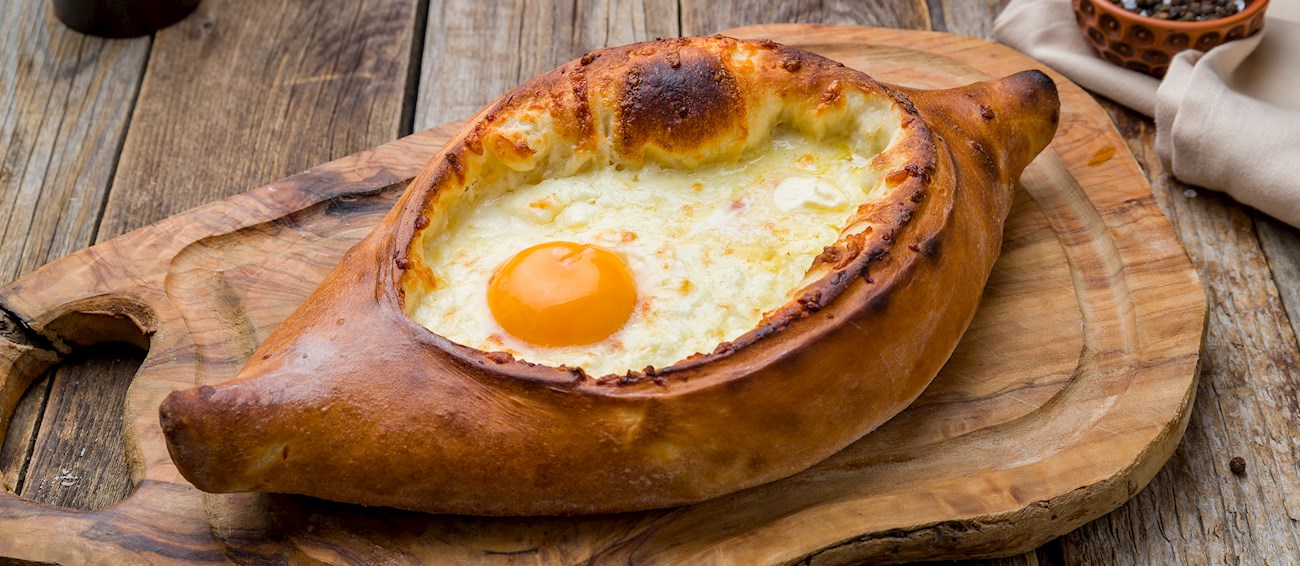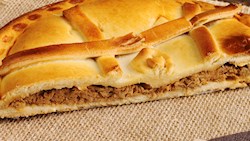MAIN INGREDIENTS
Translated as honey pie, this light Greek dessert is traditionally associated with the island of Sifnos, but its varieties can be found in other Greek regions as well. The pie combines fresh cheese, preferably mizithra based on sheep or goat milk, eggs, and honey, and it is usually baked as a round, crustless cake.
It is recommended to garnish melopita with a sprinkle of cinnamon and an additional drizzle of honey.
MAIN INGREDIENTS
This simple cheese bread known as khachapuri is the most famous dish in Georgia. It is traditionally topped with melted cheese, eggs and butter. There are different types of khachapuri, and even though some new cheese varieties such as mozzarella and feta have been incorporated in the dish, the most common additions still include traditional Georgian Sulguni or Imeretian cheese.
It is shaped into different forms, and depending on the baking procedure and its form, it can be consumed individually or shared. Two of the most common varieties include the Imeretian khachapuri, shaped into a circular form, and Adjaran khachapuri, the open-faced version topped with butter and a raw egg on top.
VARIATIONS OF Khachapuri
MOST ICONIC Khachapuri
View moreMAIN INGREDIENTS
One of the most popular khachapuri varieties, adjarian is an open-faced pie that is filled with a combination of cheese and eggs. The base is made from yeasted dough that is rolled into an oblong shape and traditionally comes filled with Sulguni or Imeretian cheese, or the combination of both.
The dish is finished off with an egg that is placed on top, and the pie is then additionally baked until the egg is partially set. This boat-shaped pie hails from the coastal Adjaria region, and it is usually served with a slice of butter on top.
MOST ICONIC Ajaruli khachapuri
View moreMAIN INGREDIENTS
This khachapuri variety hails from Guria, a province in the west of Georgia. Unlike other khachapuri pies, this one is crescent-shaped and it's prepared for Orthodox Christmas. The dough is filled with a combination of grated Imeruli cheese and hard-boiled eggs before it's baked until golden-brown.
The shape of this pie was associated with celestial bodies, and for ancient Gurians it was a symbol of strength, so nowadays there is a superstitious belief that each family member should get at least one Gurian khachapuri during the festive Christmas season.
MAIN INGREDIENTS
A typical dessert of the East Flanders, mattentaart is a small puff pastry pie with a tender, almond-flavored cheese curd filling called mattenbrij. These delicious Flemish pies are traditionally made in the city of Geraardsbergen and the neighboring village of Lierde, and their production depends heavily on the Geraardsbergen area's dairy produce, since genuine mattentaarts are prepared using only fresh milk, butter, and buttermilk from the local farms.
Although the origins of mattentaart can be traced back to the Middle Ages, the oldest known recipe was found in Een Notabel Boecxken van Cokeryen, the first cookbook in Dutch, written and published in 1514 by Thomas van Der Noot. Later on, the famed mattentaarts were even depicted by the Flemish Renaissance painter and printmaker Pieter Bruegel the Elder in his 1567 painting The Peasant Wedding.
MAIN INGREDIENTS
Plăcintă aromână, also known as plăcintă macedoneană in Romania, is a traditional pie that is usually filled with leeks or spinach, eggs, cheese, and sour cream. On a pastry sheet that has been brushed with lard, the egg-cheese filling with blanched spinach or leeks is evenly spread, topped with another dough layer, and then baked in the oven.
Once baked, the pie is usually served warm for breakfast, with a glass of yogurt on the side.
Pirog is a popular Russian pie made from yeast dough, shortcrust, or puff pastry that is filled with either sweet or savory ingredients. Some of the more popular fillings include meat, fish, mushrooms, cheese, cabbage, potatoes, and fruits such as plums, apples, or a variety of berries.
The pie can be either closed or open-faced. In Russia, pirog is so popular that it has often been considered as a sign of a good housewife.
VARIATIONS OF Pirog
MOST ICONIC Pirog
View moreSzarlotka is a traditional apple pie that is hugely popular in all of Poland. There are countless ways of making it, but typically, it's made with shortcrust pastry or semi-shortcrust pastry and cooked or raw apples. It's a double-crust pie, and the top of the pie is usually crumbled.
However, there is one variation of szarlotka that is well-known, and that is one that also includes a meringue layer underneath the crumble topping. Szarlotka can also have other fruits like peaches and pears, the apple filling can have raisins, and the crumble topping can be mixed with almonds.
Appeltaart is a traditional apple pie that is very often accompanied by a cup of hot coffee. Although it is essentially the same as most apple pies, Dutch appeltaart differs from the classic American apple pie in many ways: it is baked in a spring-form pan, making it deeper; it is drier on the interior; it is full of big chunks of apple, currants, and raisins, and it is full of speculoos spices such as cinnamon, lemon juice, and other warm spices.
Appeltaart dates back to the Middle Ages and it is believed that the baking time was measured by the number of prayers one had to say until it was ready to be taken out of the oven since ovens with temperature controls didn't exist at the time. In the Netherlands, appeltaart is usually served at room temperature and topped with a dollop of whipped cream, what is known as appeltaart met slagroom.
MOST ICONIC Appeltaart
View moreMAIN INGREDIENTS
A close relative of galaktoboureko—that is distinguished by the use of phyllo sheets—classic Greek galatopita combines semolina, milk, eggs, butter, and sugar into a creamy, custard-like treat. Often enriched with citrus zest (and wrapped in pastry in some regions), galatopita is baked until golden-brown and is typically garnished with a sprinkle of powdered sugar or cinnamon.
With its light texture and delicate flavor, it can be served on any occasion and is best enjoyed well-chilled.
TasteAtlas food rankings are based on the ratings of the TasteAtlas audience, with a series of mechanisms that recognize real users and that ignore bot, nationalist or local patriotic ratings, and give additional value to the ratings of users that the system recognizes as knowledgeable. For the “Top 100 European Pies” list until February 13, 2025, 8,656 ratings were recorded, of which 5,148 were recognized by the system as legitimate. TasteAtlas Rankings should not be seen as the final global conclusion about food. Their purpose is to promote excellent local foods, instill pride in traditional dishes, and arouse curiosity about dishes you haven’t tried.


















































































































